Legend on the reverse with 4 Chinese characters
"Yuan Heng Li Cheng"
 , 'Lien Fu Hsi Min'
, 'Lien Fu Hsi Min'  and
"Ti Te Kuang Yun"
and
"Ti Te Kuang Yun" 
| Home Page 主頁 |
New Data 最新資料 |
Chronology 歷史編年表 |
HK/Macao 港澳錢幣 |
Cast Coins 中國古錢 |
Struck Coins 機鑄幣 |
Paper Money 紙幣 |
Values/Wants 估值及征購 |
Links/References 網站參考鏈接 |
 , 'Lien Fu Hsi Min'
, 'Lien Fu Hsi Min'  and
"Ti Te Kuang Yun"
and
"Ti Te Kuang Yun" 
| I have received an e-mail from Ms. S.J. of U.S.A. on 14 Jan, 1998. When I read her e-mail, I have got to keep quiet a few minute in order to steady my thought. Because her Annamese cash is a quite rare coin. I think only very few people have seen the coin before. I received another email from Mr. Yang Rong of America on 26 February 2001. He is so kind as to send me the images of "Ti Te Kuang Yun"  of Ming Mang T'ung Pao cash that I have never seen before. Thanks indeed ! of Ming Mang T'ung Pao cash that I have never seen before. Thanks indeed !
Date: Wed, 14 Jan 1998 08:59:47 From: S.J. Subject: coin
We have a round coin with a square hole in the middle. It has four
symbols on the front and four symbols on the back. We know what some of the symbols mean. On one side there are Ming (Top) Mandate of Heaven (bottom) Tung (Left) Pao (right). on the other side
Yuan is at the top and there are three other symbols that we cannot
find. We have searched the internet and cannot find them any where. If
you know what this might be please contact me.
Or, if you know of a book that would tell what these symbols mean please forward the name of it to me
|
| Obverse | Reverse | Description |
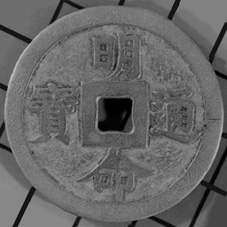 |
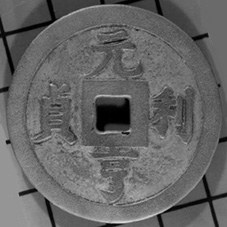 | No. 133 |
| Diam. 51 mm | ||
| Wt. 22.5 g. | ||
| Rareness B | ||
| Mint Evolution and Peculiarity | ||
|
This coin is a Vietnamese cash. In the ancient time, Vietnamese used Chinese characters for official documents and copper cash. Thought some were modified to their liking and will sometimes not match the original character of the Chinese word.
This large square holed copper cash with emperor's name on the obverse and a four- characters legend on the reverse was cast in the 11th year of the Ming Mang (Minh Mang) reign (1830AD) of the Yuan (Nguyen) Dynasty of Dai Nam (Vietnam). [For cash of this type, diameter from 50mm to 52mm and weight from 23 to 28.5 grams were found. (The second Nguyen Emperor, Ming Mang period is from 1820AD to 1841AD)] The total mintage of the same type cash are 10,000 pieces in 30 different legends. This means that cash of this type exist less than 333 pieces in the world, I guess. I think this coin is worth about US$100 to US$150 in fine condition. On the other hand, if this coin is a Chinese copper cash, it would be worth much more. The value of a coin is highly dependent on the trend of collection in the world.
According to 大南實錄 "Dai Nam Shih Lu", the second Nguyen Emperors ordered to cast 10000 pieces of the large size copper or brass cash. [The copper cash were cast with eight or four characters on the reverse] The cash were cast in 30 different legends on the 5th month of the 11th year of the Ming Mang reign (1830AD) of the Yuan Dynasty of Dai Nam (Vietnam). The inscriptions on the reverse of this large cash are four Chinese characters
When the Chinese people use | ||
| Obverse | Reverse | Description |
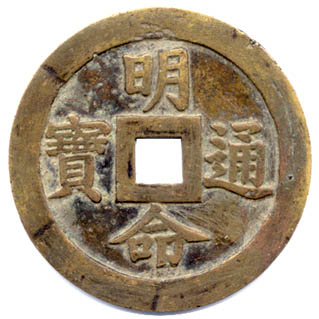 |
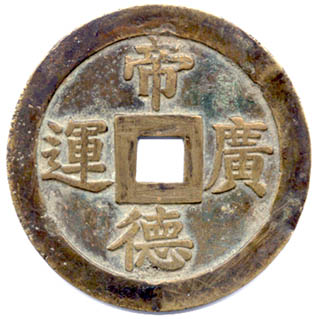 | No. 333 |
| Diam. unknown | ||
| Wt. unknown | ||
| Rareness B | ||
| Mint Evolution and Peculiarity | ||
This is the first time for me to view the Ti Te Kuang Yun cash.
May be this cash is rarer than the above one. In Chinese, Ti means 'Emperor", Te means 'morality; virtue', Kuang means 'extensive; broad' and Yun means 'carry out or carry to; employ; put into practice; luck or fortune'. All four Chinese characters  mean 'The Emperor carries out his morality and virtue broadly.' I am sure this coin is very rare among the Chinese cash collectors' circle. mean 'The Emperor carries out his morality and virtue broadly.' I am sure this coin is very rare among the Chinese cash collectors' circle.
| ||
| Obverse | Reverse | Description |
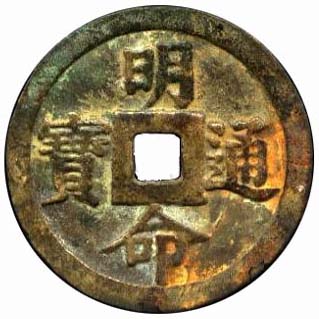 By courtesy of Mr. Watxr (明泊先生) of 易泉齋 |
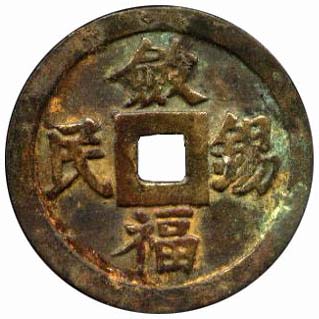 By courtesy of Mr. Watxr (明泊先生) of 易泉齋 | No. 354 |
| Diam. unknown | ||
| Wt. unknown | ||
| Rareness B | ||
| Mint Evolution and Peculiarity | ||
This Ming Mang T'ung Pao known as Lien Fu Hsi Min cash. Lien means 'collect; control or concentrate', Fu means 'Happiness; good fortune or prosperity', Hsi means 'give; grant or confer' and Min means 'The people; citizens or inhabitants'. All four Chinese characters 'Lien Fu Hsi Min'  on the reverse mean 'The Emperor collects Happiness or good fortune and gives them to his people.' The quality of this coin is very good. The Nguyen emperors opened a new phase in the history of Vietnamese coinage, copper coins minting continued, but coins were casted from zinc for the consequence of shortage of copper and silver was also introduced for responsing to the increase in foreign trade. on the reverse mean 'The Emperor collects Happiness or good fortune and gives them to his people.' The quality of this coin is very good. The Nguyen emperors opened a new phase in the history of Vietnamese coinage, copper coins minting continued, but coins were casted from zinc for the consequence of shortage of copper and silver was also introduced for responsing to the increase in foreign trade.
| ||
| Home Page 主頁 |
New Data 最新資料 |
Chronology 歷史編年表 |
HK/Macao 港澳錢幣 |
Cast Coins 中國古錢 |
Struck Coins 機鑄幣 |
Paper Money 紙幣 |
Values/Wants 估值及征購 |
Links/References 網站參考鏈接 |